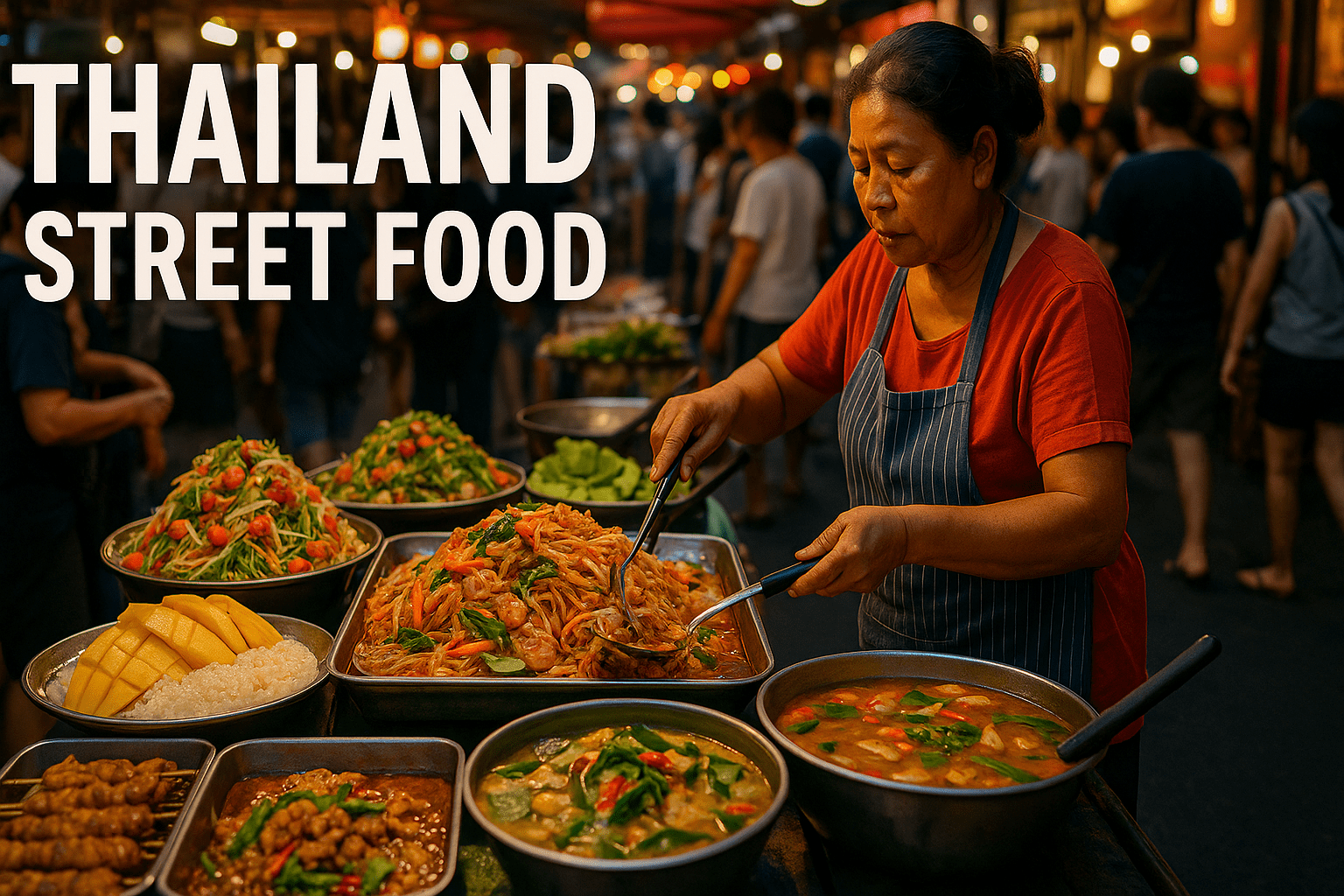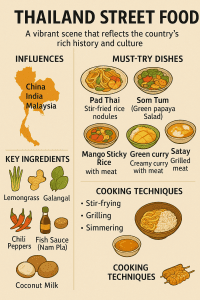
Thailand street food is a vibrant tapestry woven from centuries of culinary tradition, regional specialties, and the sheer ingenuity of its people. More than just a quick meal, it’s an integral part of Thai culture, an everyday spectacle, and an explosion of flavors waiting to be discovered.
From the bustling streets of Bangkok to the laid-back islands of the south, the aroma of sizzling spices and the chatter of vendors create an irresistible invitation to explore this culinary paradise.
A Culinary Journey Through Thai History
The roots of Thailand’s rich street food culture are intertwined with its history. For centuries, Thailand has been a crossroads of trade and migration, absorbing culinary influences from neighboring countries like China, India, and Malaysia.
These influences, combined with locally sourced ingredients and traditional cooking techniques, have resulted in a unique and diverse culinary landscape. The abundance of fresh produce, seafood, and spices has always been a cornerstone of Thai cooking, allowing street food vendors to create flavorful and affordable meals for the masses.
Street food became particularly prominent as urban centers grew and people sought convenient and affordable dining options. Bangkok, in particular, has become synonymous with street food, offering a staggering array of dishes to suit every palate. The adaptability and entrepreneurial spirit of the Thai people have also contributed to the thriving street food scene, with vendors constantly innovating and creating new and exciting dishes.
Must-Try Thailand Street Food Dishes: A Flavorful Exploration
Here’s a glimpse into some of the iconic Thailand street food dishes you simply can’t miss:
- Pad Thai: Arguably the most famous Thai dish, Pad Thai features stir-fried rice noodles with shrimp, tofu, bean sprouts, peanuts, and a tangy tamarind sauce. The balance of sweet, sour, and savory flavors makes it a true crowd-pleaser.
- Som Tum (Green Papaya Salad): A refreshing and spicy salad made with shredded green papaya, tomatoes, green beans, peanuts, dried shrimp, and a fiery chili-lime dressing. The contrast of textures and flavors is an absolute delight. Some sources state that Som Tum originated in Laos.
- Mango Sticky Rice (Khao Niao Mamuang): A classic Thai dessert featuring sweet sticky rice, ripe mango slices, and a drizzle of coconut milk. The creamy texture of the rice and the sweet, juicy mango create a heavenly combination.
- Tom Yum Soup: A hot and sour soup flavored with lemongrass, galangal, kaffir lime leaves, chili peppers, and fish sauce. It’s often served with shrimp or chicken and is known for its aromatic and invigorating properties.
- Green Curry (Gaeng Keow Wan): A fragrant and flavorful curry made with green chili paste, coconut milk, bamboo shoots, Thai basil, and meat (usually chicken or beef). The creamy texture and spicy kick make it a satisfying and comforting dish.
- Satay: Marinated meat skewers grilled to perfection and served with a rich peanut sauce. The smoky flavor of the grilled meat and the creamy, nutty sauce are a match made in heaven.
- Boat Noodles (Kuay Teow Reua): A rich and flavorful noodle soup traditionally served from boats along Bangkok’s canals. The broth is typically made with blood, spices, and herbs, resulting in a complex and unforgettable flavor.
Beyond these well-known dishes, Thailand street food offers countless other culinary treasures waiting to be discovered. From grilled meats and seafood to savory pancakes and sweet treats, there’s something to satisfy every craving. Don’t be afraid to try new things and ask vendors about their specialties – you’re sure to find some hidden gems along the way.
Exploring the Flavors: A Deeper Dive into Ingredients and Techniques
The distinct flavors of Thailand street food are derived from a careful balance of ingredients and cooking techniques. Fresh herbs and spices play a crucial role, adding depth, complexity, and aroma to every dish. Some key ingredients include:
- Lemongrass: A fragrant herb with a citrusy aroma, used extensively in soups, curries, and stir-fries.
- Galangal: A rhizome similar to ginger, but with a more peppery and citrusy flavor.
- Kaffir Lime Leaves: Aromatic leaves with a distinctive citrus scent, used to flavor soups, curries, and salads.
- Chili Peppers: Available in a wide variety of sizes and heat levels, adding a spicy kick to many Thai dishes.
- Fish Sauce (Nam Pla): A pungent sauce made from fermented fish, used as a seasoning and a source of umami flavor.
- Palm Sugar: A natural sweetener made from the sap of palm trees, used to balance the flavors of sweet and savory dishes.
- Coconut Milk: A rich and creamy liquid extracted from the flesh of coconuts, used in curries, soups, and desserts.
Thai cooking techniques also play a crucial role in shaping the flavors and textures of street food dishes. Stir-frying is a common method, allowing vendors to quickly cook ingredients over high heat while preserving their freshness. Grilling is another popular technique, imparting a smoky flavor to meats and seafood. Soups and curries are often simmered for hours, allowing the flavors to meld and deepen. One time, while visiting a local market, I saw a vendor carefully pounding spices with a mortar and pestle, explaining that this traditional method releases more flavor than using a food processor.
“Travel isn’t always pretty. It isn’t always comfortable. Sometimes it hurts, it even breaks your heart. But that’s okay. The journey changes you; it should change you. It leaves marks on your memory, on your consciousness, on your heart, and on your body. You take something with you. Hopefully, you leave something good behind.”

Finding the Best Thailand Street Food: Tips and Tricks
Finding the best Thailand street food can be an adventure in itself. Here are some tips to help you navigate the culinary landscape:
- Look for busy stalls: A long line is usually a good sign that the food is fresh and delicious.
- Observe the vendors: Cleanliness and hygiene are important factors to consider.
- Don’t be afraid to try new things: Step outside your comfort zone and sample dishes you’ve never heard of before.
- Ask the locals: Locals are the best source of information about hidden gems and authentic flavors.
- Trust your senses: If a dish smells and looks appealing, it’s likely to be delicious.
Many cities in Thailand offer organized food tours that can provide a guided introduction to the local street food scene. These tours often include visits to hidden gems and opportunities to sample a variety of dishes. You can also explore the street food markets on your own, armed with a list of must-try dishes and a sense of adventure. Some notable street food locations are Bangkok’s Yaowarat (Chinatown), Chiang Mai’s Night Bazaar, and Phuket Town’s Sunday Walking Street. The International Organization for Migration reported that tourism contributes significantly to Thailand’s economy.
Remember to be respectful of the local culture and customs. Dress modestly, ask permission before taking photos, and be mindful of noise levels. A little bit of politeness goes a long way in Thailand.
Beyond the Plate: The Cultural Significance of Thailand Street Food
Thailand street food is more than just a meal; it’s a social and cultural experience. It’s a place where people from all walks of life come together to share a meal and connect with their community. Street food vendors are often family-run businesses, passing down recipes and traditions from generation to generation. The act of preparing and sharing food is a way of preserving cultural heritage and strengthening social bonds. Authenticity is key to the experience.
Street food also plays an important role in the Thai economy, providing livelihoods for millions of people. It’s a testament to the entrepreneurial spirit and resilience of the Thai people. The vibrant street food scene attracts tourists from all over the world, contributing to the country’s economic growth. Many sources indicate that street food accounts for a substantial portion of the country’s tourism income.
The government has also recognized the importance of street food and has taken steps to support and promote the industry. Initiatives such as food safety training programs and street food festivals are helping to ensure the quality and sustainability of the street food scene. The efforts of the government are improving the country’s perception of quality which leads to increase in tourism, reported by the United Nations Economic and Social Commission for Asia and the Pacific.
Bringing Thailand Street Food Home
While nothing quite compares to experiencing Thailand street food firsthand, you can bring a taste of Thailand into your own kitchen. Many Thai dishes are relatively easy to prepare at home, using readily available ingredients. You can find authentic Thai recipes online and in cookbooks, or even take a Thai cooking class to learn the basics. Learning how to prepare dishes like Pad Thai or Green Curry from scratch can be a rewarding experience, allowing you to recreate the flavors of Thailand in your own home.
Experiment with different ingredients and techniques to find your own favorite Thai dishes. Don’t be afraid to adjust the recipes to suit your taste preferences. And most importantly, have fun and enjoy the process of cooking and sharing Thai food with your friends and family. You can also get some inspiration from Asian culture in general.
Conclusion: A Culinary Adventure Awaits
Thailand street food is a culinary adventure that will tantalize your taste buds and leave you with unforgettable memories. From the iconic Pad Thai to the exotic Tom Yum soup, there’s a dish to suit every palate. So, pack your bags, grab your appetite, and prepare to embark on a delicious journey through the vibrant streets of Thailand. Remember to be open to new experiences, be respectful of the local culture, and most importantly, have fun exploring the incredible world of Thailand street food.
Embrace the chaos, savor the flavors, and let the sights, sounds, and smells of Thailand street food transport you to a world of culinary delight. The flavors of Thailand are a testament to the country’s rich history, cultural diversity, and the passion of its people. Go forth and explore – your culinary adventure awaits!
Whether you are planning a trip or want to prepare authentic recipes at home, make sure to keep in mind the balance of flavors is essential in Thai cuisine. Sweet, sour, spicy, salty, and umami are all necessary to create the perfect Thai dish. Remember this when preparing to embark on this culinary journey.







